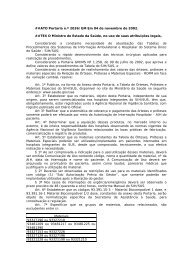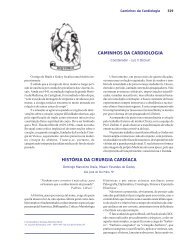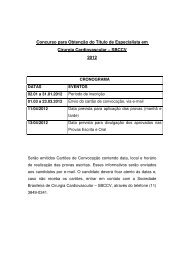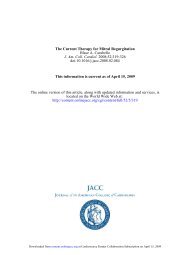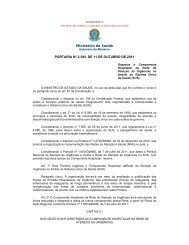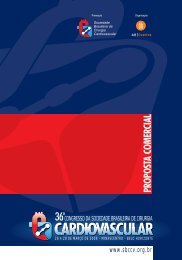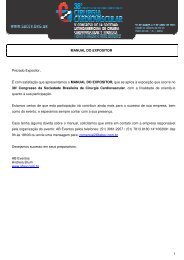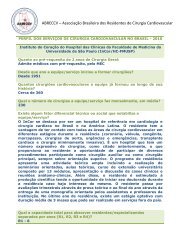“Hybrid” Repair of Aneurysms of the Transverse Aortic Arch: Midterm ...
“Hybrid” Repair of Aneurysms of the Transverse Aortic Arch: Midterm ...
“Hybrid” Repair of Aneurysms of the Transverse Aortic Arch: Midterm ...
You also want an ePaper? Increase the reach of your titles
YUMPU automatically turns print PDFs into web optimized ePapers that Google loves.
1886 HUGHES ET AL Ann Thorac Surg<br />
HYBRID ARCH REPAIR 2009;88:1882–8<br />
ADULT CARDIAC<br />
vascular leak secondary to an intercostal artery and is<br />
being followed. No patient has a type 1 or 3 endovascular<br />
leak at latest follow-up.<br />
Clinical success, defined as absence <strong>of</strong> death as a result<br />
<strong>of</strong> aneurysm-related treatment, persistent type 1 or 3<br />
endovascular leak, graft infection or thrombosis, aneurysm<br />
expansion or rupture, or conversion to open repair<br />
[13] was 100% at a mean duration <strong>of</strong> follow-up <strong>of</strong> 14 11<br />
months (range, 1 to 36). Overall actuarial midterm survival<br />
is 70% at 36 months, with an aorta-specific actuarial<br />
survival <strong>of</strong> 100% during this same interval.<br />
Comment<br />
<strong>Aneurysms</strong> <strong>of</strong> <strong>the</strong> transverse aortic arch, especially those<br />
involving <strong>the</strong> mid to distal arch, are technically challenging<br />
to repair with conventional open techniques. These<br />
challenges relate to difficulties with exposure, need for<br />
deep hypo<strong>the</strong>rmic circulatory arrest, and frequent requirement<br />
for a two-stage approach to complete repair.<br />
Total arch replacement, although now performed routinely<br />
and safely in centers with expertise, still carries a<br />
perioperative death or stroke rate approaching 15%, even<br />
in expert hands [8, 14]. Fur<strong>the</strong>r, a significant number <strong>of</strong><br />
patients may become unfit or refuse <strong>the</strong> second stage,<br />
and perioperative second stage mortality rates approach<br />
10% for patients fit enough to undergo an additional<br />
open procedure for downstream repair [15]. This is in<br />
contrast to <strong>the</strong> results <strong>of</strong> <strong>the</strong> present report, in which no<br />
deaths or strokes were seen in 28 consecutive patients<br />
undergoing hybrid arch repair. Similar low rates <strong>of</strong><br />
perioperative morbidity and mortality with hybrid arch<br />
repair have been reported by o<strong>the</strong>rs [3, 16].<br />
Potential advantages <strong>of</strong> <strong>the</strong> hybrid approach over conventional<br />
repair for arch pathology are several. First,<br />
<strong>the</strong>se procedures, which avoid <strong>the</strong> need for cardiopulmonary<br />
bypass and aortic cross-clamping in most patients,<br />
may have advantages for high-risk patients, including<br />
<strong>the</strong> potential to <strong>of</strong>fer <strong>the</strong>rapy to patients who are not<br />
candidates for conventional open repair [4]. Second, endovascular<br />
grafts can be deployed from <strong>the</strong> ascending aorta<br />
down to <strong>the</strong> level <strong>of</strong> <strong>the</strong> celiac axis, thus allowing pathology<br />
<strong>of</strong> <strong>the</strong> arch and descending aorta previously requiring<br />
ei<strong>the</strong>r extensive single stage repair through bilateral thoracosternotomy<br />
[17] or two-stage repair [15, 18–20] to be<br />
treated in a single-stage procedure. Finally, for patients<br />
still requiring a two-stage approach, <strong>the</strong> second-stage<br />
endovascular repair may be performed much sooner<br />
than a second open procedure (even during <strong>the</strong> same<br />
hospitalization as arch replacement, as was done in<br />
nearly a third <strong>of</strong> patients in <strong>the</strong> current series), given <strong>the</strong><br />
minimal physiologic insult <strong>of</strong> TEVAR and <strong>the</strong> fact that it<br />
is well tolerated even by patients who have recently<br />
undergone major open surgery. This represents a significant<br />
advance over conventional open second-stage repair<br />
and may eliminate <strong>the</strong> known risk <strong>of</strong> death from<br />
distal aortic complications between stages [15, 18–20].<br />
Fur<strong>the</strong>r, large series <strong>of</strong> patients undergoing first-stage<br />
elephant trunk demonstrate that only approximately 50%<br />
return for open second-stage repair [15, 18–20], a number<br />
that should be greatly improved when <strong>the</strong> second procedure<br />
is performed using endovascular means. This is<br />
evidenced by all patients in <strong>the</strong> current series who<br />
underwent first-stage elephant trunk also underwent<br />
subsequent second-stage repair.<br />
The so-called frozen elephant trunk technique [21–23]<br />
has also been suggested as a means to treat extensive<br />
thoracic aortic aneurysm in a single-stage procedure.<br />
This technique involves placement <strong>of</strong> an endovascular<br />
stent graft antegrade through <strong>the</strong> open arch at <strong>the</strong> same<br />
operation as <strong>the</strong> elephant trunk procedure. Although this<br />
approach has <strong>the</strong> advantage <strong>of</strong> eliminating <strong>the</strong> potential<br />
for interval aortic-related death between stages, it adds<br />
additional physiologic insult to an already significant<br />
operation. That is especially true with regard to renal<br />
function if contrast angiography is utilized for <strong>the</strong> endovascular<br />
graft portion <strong>of</strong> <strong>the</strong> case. As such, we believe<br />
<strong>the</strong>se procedures are best staged, even if only for a few<br />
days, to allow <strong>the</strong> patient some recovery period after total<br />
arch replacement. The results <strong>of</strong> <strong>the</strong> present series would<br />
appear to support this contention, given <strong>the</strong> lack <strong>of</strong><br />
interval mortality between staged repairs. Fur<strong>the</strong>r, rates<br />
<strong>of</strong> spinal cord ischemia appear increased with <strong>the</strong> frozen<br />
elephant trunk approach, averaging 10% in most series [21,<br />
23]. One potential explanation for this observation is that<br />
<strong>the</strong> ability to maintain supranormal mean arterial pressures<br />
to augment spinal cord blood flow may be limited by<br />
bleeding complications in this scenario, and that <strong>the</strong> use <strong>of</strong><br />
cerebrospinal fluid drainage may be contraindicated owing<br />
to concerns over coagulopathy and central nervous system<br />
bleeding complications. There were no episodes <strong>of</strong> spinal<br />
cord ischemia after second-stage endovascular grafting in<br />
patients undergoing initial elephant trunk in <strong>the</strong> present<br />
series, which may support this hypo<strong>the</strong>sis.<br />
One potential word <strong>of</strong> caution with regard to <strong>the</strong> use <strong>of</strong><br />
ascending aorta-based arch debranching procedures relates<br />
to <strong>the</strong> use <strong>of</strong> existing Dacron grafts for PLZ. Both<br />
type 1 endovascular leaks observed in this series were<br />
proximal type 1 leaks around endovascular grafts with<br />
proximal seal zone in an ascending Dacron graft. That<br />
equates to a 50% type 1 endovascular leak incidence in<br />
this group, as only 4 patients had PLZ in an ascending<br />
Dacron graft. We speculate that <strong>the</strong> presence <strong>of</strong> an<br />
endograft in a Dacron graft may promote additional<br />
dilation <strong>of</strong> <strong>the</strong> Dacron above that normally occurring,<br />
thus leading to late endovascular leak formation. Alternatively,<br />
<strong>the</strong> less compliant nature <strong>of</strong> Dacron as compared<br />
with native aorta may result in suboptimal endograft apposition.<br />
Although both proximal endovascular leaks in <strong>the</strong><br />
current series were successfully treated with proximal cuff<br />
extensions, this is technically challenging because <strong>of</strong> <strong>the</strong><br />
100-cm length <strong>of</strong> <strong>the</strong> devices and difficulty reaching <strong>the</strong><br />
ascending aorta from <strong>the</strong> groin at a second procedure. In<br />
1 <strong>of</strong> <strong>the</strong> 2 patients, <strong>the</strong> endograft had to be deployed<br />
“bareback” without a sheath to allow it to reach far<br />
enough proximally into <strong>the</strong> ascending graft to achieve<br />
proximal seal. Based on <strong>the</strong>se results, we suggest oversizing<br />
<strong>the</strong> endograft 20%, as well as a PLZ <strong>of</strong> at least 4 cm,<br />
when landing in Dacron to prevent this complication.



